| 1 | A tiny US forest snake |
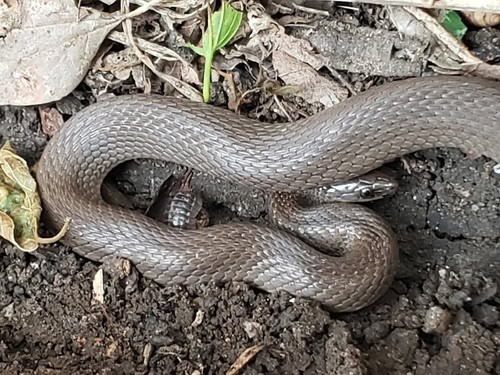
The rough earth snake is a non-venomous species found mainly in the eastern USA, which only rarely exceeds 30cm. This is a shy snake which nearly always hides below a reassuring cover object. Rough earth snakes are virtually never seen out in the open, slithering over a road or down a bare hillside. Their dens are pine woods, hardwood forests, edges of swamps, and grasslands adjacent to woodlands, usually with plenty of cover objects. Forests are their main spot, including hilly forests.
Rough earth snakes are very rare in arid or semi-desert regions, only appearing here along the wooded, moist shores of rivers. They often thrive in suburban areas, lurking in compost heaps, flower beds, and vacant lots scattered with cardboard boxes.
This species commonly rests together under favourable shelter, all being drawn to the same hideyholes with their supreme senses. Rough earth snakes average at 18-25cm, with a maximum confirmed record of 34.8cm. Another record mentioned is 32.4cm. This is also a thin snake with a diameter no larger than a pencil.
| 2 | Brown with a creamy belly |
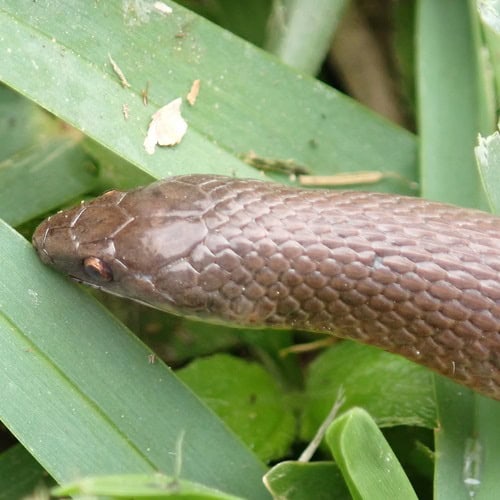
Rough earth snakes (Virginia striatulus) primarily inhabit the eastern USA. Their extreme western point is central Texas, while to the northeast they cross well over the border into Virginia. In Florida, they mainly occupy the panhandle, skipping most of the peninsular. Rough earth snakes almost reach the Mexican border in Texas, but fall short, meaning that their entire range lies in the USA.
As juveniles, rough earth snakes have a pale neck band, which could cause confusion with the ring-necked snake, another shy forest lover. But this vanishes totally in adulthood, rendering them a plain brown from above. Though virtually impossible to see, each scale has a subtle stripe down the centre, hence the Latin name of striatula (striped). From a distance, there’s a total lack of patterns, just a monolithic brown colour. Its belly is more identifiable, ranging from cream to pale yellow, occasionally with a pinkish or grassy green tone.
In March 1982, a group of 30 hibernating rough earth snakes were accidentally dug up near Richmond, Virginia. It’s possible that they use scent to detect where their fellow kind takes shelter, and follow their lead. In certain golden spots, dozens of rough earth snakes can be found in a few hours.
| 3 | Lives among woodlice and beetles |
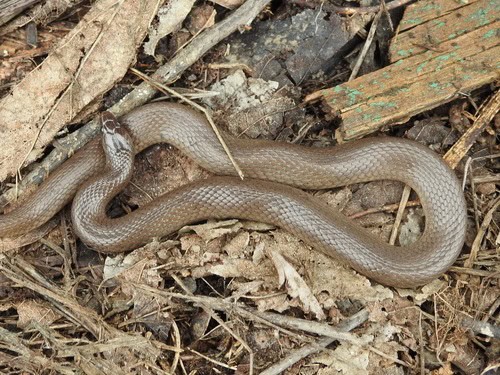
The natural habitat of rough earth snakes isn’t underground like a blind snake. Nor is it charging confidently through a field like a black racer. They prefer inbetween: the semi-subterranean layer of forests consisting of rotting forest mulch, fallen pine needles and rocks. This soft material is easy to bury themselves in without having state-of-the-art burrowing abilities. They also lurk under loose cover objects, like rotting logs in forests or a tree stump cracked in the middle. In Beeville County, one was even found below an abandoned vacuum cleaner near a burnt out field.
A top spot might be rocks by the side of a well established hiking trail through a forest, steadily gaining height while you pant and sweat under the weight of your rucksack.
Virginia striatula have been found hiding underneath flat rock slabs at the tops of hillsides in Cherokee County, Kansas. In Chautauqua county, Kansas, rough earthsnakes have been found below sandstone rock slabs on south-facing hill slopes. They also use manmade objects like asphalt slabs discarded in a grassy field, as observed in Cherokee county, Kansas, and rusting metal on old abandoned farms.
| 4 | Earthworm obsessions |
Virginia striatula is a highly specialised predator. Small snakes that rarely exceed 30cm have a few options: ants and salamanders for ring-necked snakes, and caterpillars and spiders for smooth green snakes. Rough earth snakes have found themselves in the earthworm niche, as in a study covering 45 stomachs, earthworms were the only prey found.
Rough earth snakes are neither constrictors nor venomous. Instead, they grab their prey, rapidly reposition them before they can comprehend what’s occurring, and swallow them alive. They use the most basic methods imaginable, succeeding due to an earthworm’s lack of flexibility.
The toughest time of a rough earth snake’s life is extreme droughts, when earthworms become much less available. They very occasionally eat other prey, such as slugs, ants and snails. For example, a 1973 report mentioned a Virginia strialata feasting on ant eggs. Several ants were crawling on its back, but none were biting the snake, apparently not comprehending the danger.
| 5 | No threat to humans |
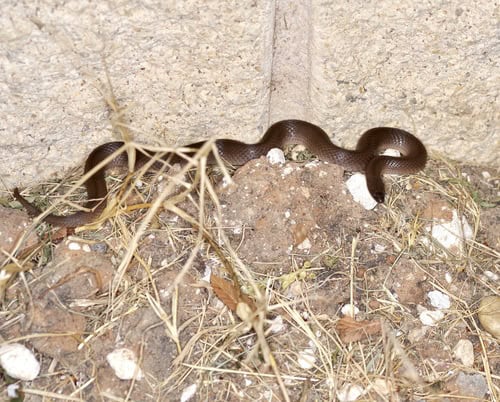
Rough earth snakes lack venom or sharp tearing fangs, and are no threat to humanity’s continued survival. If you rip up its cover object, whether a cardboard box or mossy rock, the rough earth snake will freeze for a few seconds. Then they’ll slowly crawl to a fresh cover object, attempting to vanish out of sight.
Virginia strialata is sluggish, and if picked up, they almost never bite. Their default is to discharge a vile serpent smell, spreading in a surprisingly large cloud around them, to force enemies to drop them.
While rare, they were also reported in 1976 to feign death. This captive rough earth snake repeated the routine several times over the weeks. First it contorted and twisted its body for 45 seconds. Then it went still, flipped onto its back, and went stiff, like it was faking rigor mortis. It contorted its body horribly and even lolled its tongue out. It usually maintained the charade for several minutes, before reactivating. Rough earth snakes can also save themselves from larger snakes by biting onto their predator’s body, even if partway swallowed, forcing the brutish bully serpent to regurgitate them again.
| 6 | Comparison: smooth earth snake |
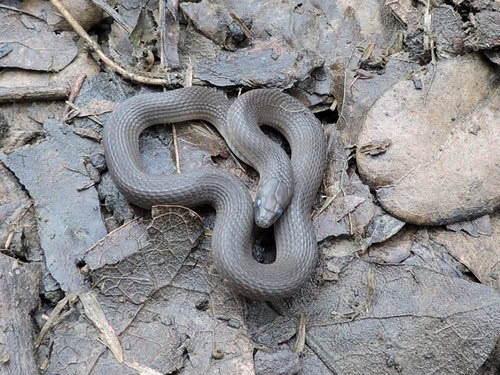
Rough earth snakes were discovered eons ago, back in 1766, when they were dubbed Coluber striatulus. While the latter name has remained, the genus it belongs to continues to shift over 250 years later. The most recent change was from Haldea striatulus to Virginia striatulus in 2023, at which point the Haldea genus ceased to exist, as rough earth snakes were the only member.
The other Virginia genus member (there’s only 2) is the smooth earth snake, which has a very similar range to its cousin: central Texas eastwards, skimming only northern Florida. The physical difference between the two is right in their names. Rough earth snakes are also plainer in colour, as smooth earth snakes sometimes have fine black spots smattered on their back, like a slight sprinkle of pepper.
Finally, the rough species is longer and heavier. A 1995 study sampled many in North Carolina, and found that the longest 5 males measured: 21.2-22.0cm for rough earth snakes, and 18.9-19.9cm for smooth. For females, rough won again at 23.9–26.8cm for the 5 largest, and 20.9-24.2cm for smooth earth snakes. Females are longer in both species.
| 7 | Most active during spring |
Weather has an effect too. The best time to spot Virginia striatula is apparently moist, warm spring nights. Virginia striatula has a close correlation with rainfall. For example, a 1976 study from Brazos County, Texas sampled local rough earth snake numbers for 35 months. The quantity collected in each month had a strong correlation with the rainfall totals that month plus the previous two months. In 1969, the population density was estimated at 348 rough earth snakes per hectare. The species also had a decent home range of 100 square metres for adult females.
In summer they often become less active, due to hot weather drying up surface moisture, making their earthworm prey less abundant, causing the rough earth snake to retreat underground. Virginia striatula varies its lifestyle, acting nocturnally during summer, and moving more by day during spring and autumn.
Come late October, your chance disappears, as rough earth snakes retreat deep underground to avoid the unstoppable arrival of cold weather, as solar radiation drains from the northern hemisphere. Rough earth snakes usually emerge in March or early April, depending on climate.
| 8 | Interactions with fellow snakes |
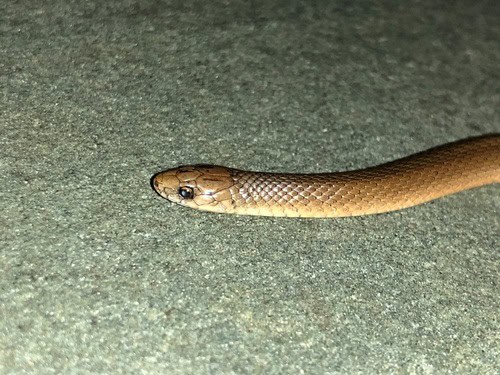
The vast majority of connections to fellow snakes involve getting eaten by them. Rough earth snakes eat zero snakes themselves, but their 20cm pocket size makes them a snack on numerous species’ menu:
Pygmy rattlesnake – the smallest rattlesnake in the USA, but not too small to swallow a rough earth snake whole. They are confirmed victims in the wild, alongside Dekay’s brown snakes, ringneck snakes and smooth earth snakes. The pygmy rattlesnake which regurgitated the Virginia striatula measured just 37.1cm.
Rock rattlesnake – this Arizona species doesn’t overlap with rough earth snakes, but they have eaten them happily in captivity.
Speckled kingsnake – in April 2015, scientists found a roadkill speckled kingsnake (Lampropeltis holbrooki) in Randolph County, Arkansas. The tyre had sliced its stomach open, and out spilled a 29.2cm rough earthsnake. The predator snake measured 79.2cm. Smooth earth snakes are also confirmed in their diet.
Scarlet kingsnake/mole kingsnake – both are confirmed predators of rough earth snakes, so the Lampropeltis kingsnake family seems to have a particular taste for them.
| 9 | Simple to keep in captivity |
Their diet makes rough earth snakes simple to feed in captivity; walk down to the supply shop and buy a giant barrel of earthworms. They’re easy to keep happy in a woodland-style terrarium with plenty of loose wood around. With a small home range, they don’t require vast acres to patrol to satisfy their natural instincts. The biggest problem is simply that they’re not very interesting, staying in their mulch and rarely poking their head up.
Virginia striatula have a mildly pointed snout for digging through soft upper forest layers, but fall short of the hardened shield-nosed snakes of India and other true burrowers. One strange anomaly is that while female Virginia striatula are larger and heavier, males have a larger gape size, i.e. they can unhinge their mouth wider, as shown by a 2014 study. It’s theorised that this allows them to eat larger forms of earthworms, allowing them to compete with the larger females. The study incorporated 310 males and 329 females.
Somehow, scientists have never recorded the exact species they eat. North America has 161 earthworm species, 116 native and 45 introduced. The Kirtland’s snake is actually smart enough to reject invasive European slugs and eat native American ones. But the signs suggest that Virginia striatula is less fussy. In central Texas, there are no native earthworms, yet they’re still thriving. Earthworms have spread through many means: discarded fishing bait, transportation of worm cocoons in soil on tyres, soil attached to cattle feet. It’s possible that since European colonisation, we’ve actually made rough earth snakes more common, by increasing their prey base. Or it’s possible that they always inhabited central Texas, but switched from tougher prey (maybe ants) to juicy earthworms once they spread.
| 10 | Can’t cope with fire ants |
Aside from its smooth cousin, the rough earth snake’s closest relatives among the 3900 snakes species worldwide are the Storeria brown snake family. This has 3 members, including the Dekay’s brown snake and redbelly snake, found in the eastern USA. They’re also closely related to the Kirtland’s snake of Ohio, another 30cm snake which feeds on earthworms. Their next closest relatives are the semi-aquatic Liodytes group, which includes black swamp snakes and striped crayfish snakes.
Rough earth snakes lay live young rather than eggs, usually in later summer. These come in small batches; when 16 litters were tested, the range was just 3-8. One of their hidden nemeses is fire ants, native to South America, but invasive in the USA. Fire ants and rough earth snakes actually have a similar population boundary: central Texas, where moist soils switch to dry arid countryside, which both cannot cope with.
In eastern Texas, many areas where rough earth snakes thrived are now covered only with fire ant swarms, stealing their microhabitat beneath surface cover objects. For some reason, the two have an inverse correlation, with the fire ants winning.
